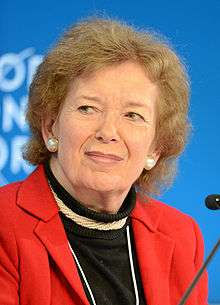Irish presidential election, 1990
| | |||||||||||||||||||||||||||||||
| |||||||||||||||||||||||||||||||
| |||||||||||||||||||||||||||||||
| |||||||||||||||||||||||||||||||
The Irish presidential election of 1990 was the tenth presidential election to be held in Ireland, and only the fifth to be contested by more than one candidate and the first to have a female candidate. It was held on Wednesday, 7 November 1990.
Candidates
Brian Lenihan
Brian Lenihan, the Tánaiste and Minister for Defence was chosen by Fianna Fáil as their candidate, though he faced a late challenge for the party nomination from another senior minister, John Wilson, TD. Lenihan was popular and widely seen as humorous and intelligent. He had delivered liberal policy reform (relaxed censorship in the 1960s), and he was seen as a near certainty to win the presidency.
Austin Currie
Fine Gael, after trying and failing to get former Taoiseach Garret FitzGerald and former Tánaiste Peter Barry to run, ultimately nominated the former civil rights campaigner and SDLP member Austin Currie. Currie had been elected to the Dáil in the 1989 general election and had been a minister in Brian Faulkner's power-sharing executive in Northern Ireland from 1973–1974. However Currie had little experience in the politics of the Republic and was widely seen as the party's last choice, nominated only when no-one else was available.
Mary Robinson
The Labour Party let it be known that it would for the first time run a candidate. Along with the Workers' Party, Labour nominated the independent candidate Mary Robinson, SC, a former Labour Party member and senator, and liberal campaigner. Robinson was a former Reid Professor of Law in the Trinity College, Dublin. She was previously involved in the Campaign for Homosexual Law Reform and the campaign to save Wood Quay.
Campaign
Lenihan entered the race as odds-on favourite; no Fianna Fáil candidate had ever lost a presidential election. However Lenihan was derailed when he confirmed in an on-the-record interview with freelance journalist and academic researcher Jim Duffy that he had been involved in controversial attempts to pressurise the President, Patrick Hillery over a controversial parliamentary dissolution in 1982. When the contrast between his public denials during the campaign and his confirmation during his earlier interview (recorded in May) he was dismissed from the Irish government.
At this point a cabinet colleague, Pádraig Flynn launched a controversial personal attack on Mary Robinson "as a wife and mother", an attack that was itself attacked in response as "disgraceful" on live radio by Michael McDowell, a senior member of the Progressive Democrats, then in coalition with Fianna Fáil and up to that point supporting Lenihan's campaign. Flynn's attack was a fatal blow to Lenihan's campaign, causing many female supporters of Lenihan to vote for Robinson in a gesture of support.
Lenihan nonetheless received a plurality of first-choice votes. Mary Robinson beat Austin Currie, forcing Fine Gael's candidate into third place. Under Ireland's system of single transferable vote Robinson received over 75% of the transfers when Austin Currie was eliminated, beating Lenihan into second place and becoming the seventh President of Ireland.
Result
| Irish presidential election, 1990[1] | ||||||
|---|---|---|---|---|---|---|
| Party | Candidate | Nominated by | % 1st Pref | Count 1 | Count 2 | |
| Independent | Mary Robinson | Labour Party, Workers' Party | 38.9 | 612,265 | 817,830 | |
| Fianna Fáil | Brian Lenihan | Fianna Fáil | 44.1 | 694,484 | 731,273 | |
| Fine Gael | Austin Currie | Fine Gael | 17.0 | 267,902 | ||
| Electorate: 2,471,308 Valid: 1,574,651 Spoilt: 9,444 (0.6%) Quota: 787,326 Turnout: 64.1% | ||||||
Aftermath
While the role of the presidency in day-to-day politics is a very limited one, the Robinson presidency is regarded by many observers as a watershed in Irish society, symbolising the shift away from the conservative ultracatholic male-dominated Ireland which existed up until the end of the 1980s to the more liberal society symbolised by Robinson.
Robinson is generally credited with raising the profile of the office of president, which had been considered little more than an honorary figurehead position under her predecessors. Indeed, prior to the Robinson presidency it was not unusual to hear commentators advocating the abolition of the office of president (a viewpoint that is almost never advanced nowadays).
See also
References
- ↑ "Presidential Election November 1990". ElectionsIreland.org. Archived from the original on 17 February 2011. Retrieved 23 November 2009.

.jpg)